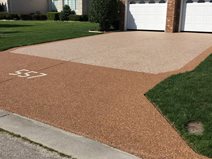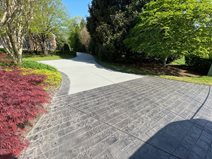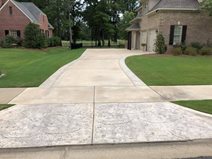What part of your driveway gets the most use and abuse, as well as the most attention? For most residential driveways, it’s the apron—that portion of the driveway installed right at the entrance, typically extending from the street side of the sidewalk to the road.
Find concrete driveway contractors near me.
Also called an approach, an apron serves as the welcome mat to your home and also performs several important functions. A variety of paving materials can be used to build a driveway apron, but choosing the right one for your property is influenced by a number of different factors. Here’s all you need to know before installing a new driveway apron or replacing an existing one.
Ideas for a Concrete Driveway Apron
Check out the design ideas below for inspiration on how to give your concrete driveway apron maximum curb appeal:

Distinguished Designs LLC in Chesapeake, VA
Put Your Number On It
Stenciling a street number into a concrete driveway apron is a practical way to identify your address while also serving as a distinctive decorative accent. Using a contrasting color for the apron and driveway border is another attention-getting feature that sets this driveway apart.

Champney Concrete Finishing in Lynchburg, VA
Establish a Theme
A decorative concrete overlay engraved with a circular tree motif greets visitors at the driveway entrance to this magnificent estate, reflecting its wooded surroundings. To further enhance the apron, it was adorned with a random stone pattern colored with spray-applied pigments. The same tree motif was duplicated at the opposite end of the driveway.

SUNDEK of Nashville in Goodlettsville, TN
Apply a Stamped Design
A great way to break up the monotony of a long, winding concrete driveway is to apply a stamped pattern to the apron and continue it along the driveway border. Only stamping the apron rather than the entire driveway is also a good way to save money when installing a large pavement such as this one.

PennyEarned, LLC in Montgomery, AL
Add Some Texture
Instead of color, you can also use texture to set off an apron from the rest of a driveway. For this short driveway approach, texture skins were used to produce a seamless look that transitions nicely into the adjacent concrete sidewalk.

Ozark Pattern Concrete, Inc. in Lowell, AR
Mix and Match
Mixing two different stamped patterns, using one for the approach and another for the main driveway fields, creates stunning visual contrast while segmenting the driveway into various zones for parking and pedestrian traffic. The same Old English bond pattern used for the apron is echoed in a pathway leading to the front door.

karamysh / Shutterstock
Play Around With Paver Patterns
Arranging decorative concrete pavers in different patterns is a simple but effective way to differentiate the apron from the rest of the driveway. Pavers are a great material to use for a driveway approach because they can easily be removed and replaced if road work needs to be done.
